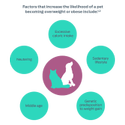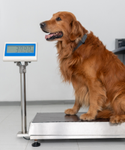

While prevention is the best strategy, a weight management plan can help overweight or obese pets to achieve and maintain a healthy body condition.
Weight management plans for pets should incorporate nutrition, exercise, and an understanding of the interaction between pet and owner.

Determining energy requirements for weight loss
A key step in weight management is determining a pet’s maintenance energy needs.
Maintenance energy requirements (MER) are based on the needs of an “average” dog or cat and can differ greatly among individual dogs and cats, based in part on age, gender, neuter status, lifestyle, and individual metabolism.
During development of a weight loss plan, MER can be calculated based on the pet’s current body weight or on target body weight (estimated based on current weight and BCS).3 Online calculators for dogs and cats can be utilized. When making MER recommendations, it is important to note that drastic calorie restriction increases the risk of creating nutrient deficiencies, so obese pets should be restricted gradually and monitored closely during weight loss.3-5 An alternative approach to making a recommendation based on MER calculations is to reduce current caloric intake, if a complete diet history is known.3 Regardless of the method used to determine daily calories, calculations are estimates, and adjustments will likely be needed to achieve desired weight loss.
Caloric restriction should be targeted for gradual weight loss of 1-2% of body weight per week for dogs and 0.5% up to 1-2% per week for cats, which helps maintain lean body mass and mitigate rebound weight gain.5-7 Rapid weight loss should also be avoided since it can put cats at risk of developing hepatic lipidosis.5,8 Due to this risk, cat owners should report immediately if their pet is refusing to eat the recommended weight loss diet.
A therapeutic weight loss diet, formulated to provide complete and balanced nutrition with less caloric impact,9 may be preferable to feeding a smaller amount of the pet's current food, as restricting maintenance diets may result in an inadequate intake of essential nutrients9,10 and may leave the pet unsatiated leading to food-seeking behaviors.5
Explore areas of managing a healthy weight
Find out more
- Bomberg, E., Birch, L., Endenburg, N., German, A. J., Neilson, J., Seligman, H., Takashima, G., & Day, M. J. (2017). The financial costs, behaviour and psychology of obesity: A one health analysis. Journal of Comparative Pathology, 156(4), 310–325.
- Larsen, J. A., & Villaverde, C. (2016). Scope of the problem and perception by owners and veterinarians. Veterinary Clinics of North America: Small Animal Practice, 46(5), 761–772.
- Linder, D. E., Freeman, L. M., Morris, P., German, A. J., Biourge, V., Heinze, C., & Alexander, L. (2012). Theoretical evaluation of risk for nutritional deficiency with caloric restriction in dogs. Veterinary Quarterly, 32(3–4), 123–129. doi: 10.1080/01652176.2012.733079
- Grant, C. E., Shoveller, A. K., Blois, S., Bakovic, M., Monteith, G., & Verbrugghe, A. (2020). Dietary intake of amino acids and vitamins compared to NRC requirements in obese cats undergoing energy restriction for weight loss. BMC Veterinary Research, 16, 426. doi: 10.1186/s12917-020-02649-0
- Brooks, D., Churchill, J., Fein, K., Linder, D., Michel, K. E., Tudor, K., Ward, E., & Witzel, A. (2014). 2014 AAHA weight management guidelines for dogs and cats. Journal of the American Animal Hospital Association, 50(1), 1–11. doi: 10.5326/JAAHA-MS-6331
- Laflamme, D. P., & Kuhlman, G. (1995). The effect of weight loss regimen on subsequent weight maintenance in dogs. Nutrition Research, 15(7), 1019–1028.
- German, A. J., Holden, S. L., Mather, N. J., Morris, P. J., & Biourge, V. (2011). Low-maintenance energy requirements of obese dogs after weight loss. British Journal of Nutrition, 106, S93–S96. doi: 10.1017/S0007114511000584
- Weeth, L. P. (2016). Other risks/possible benefits of obesity. Veterinary Clinics of North America: Small Animal Practice, 46, 843–853. doi: 10.1016/j.cvsm.2016.04.007
- Laflamme, D. P. (2012). Obesity in dogs and cats: What is wrong with being fat? Journal of Animal Science, 90, 1653–1662. doi: 10.2527/jas2011-4571
- Gaylord, L., Remillard, R., & Saker, K. (2018). Risk of nutritional deficiencies for dogs on a weight loss plan. Journal of Small Animal Practice, 59, 695–703. doi: 10.1111/jsap.12913


